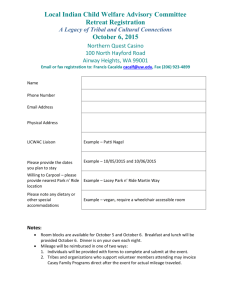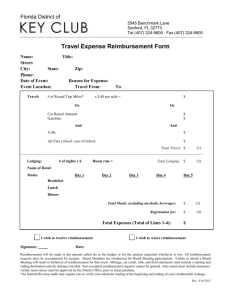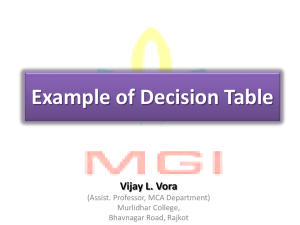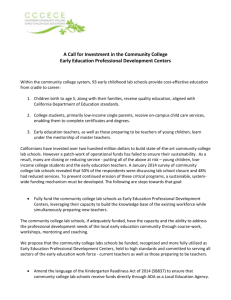Ride Connection: Mileage Reimbursement DOC
advertisement
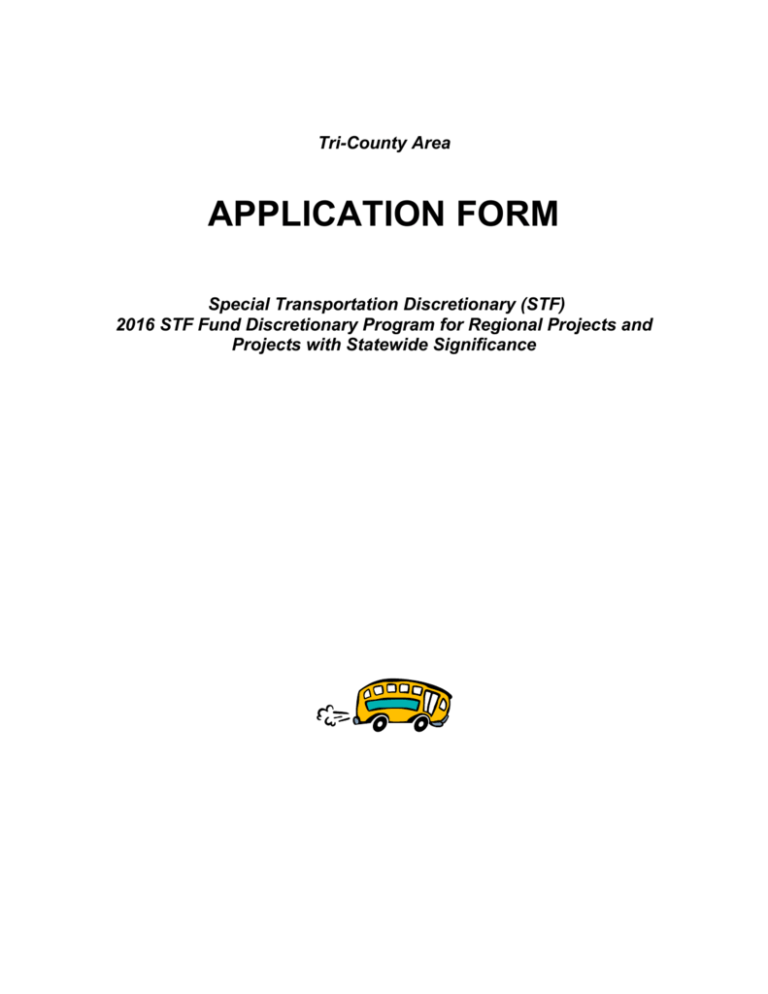
Tri-County Area APPLICATION FORM Special Transportation Discretionary (STF) 2016 STF Fund Discretionary Program for Regional Projects and Projects with Statewide Significance 2016 STF Fund Discretionary Program for Regional Projects and Projects with Statewide Significance GRANT APPLICATION I. Organization’s Information Name of Organization: Ride Connection Contact Person: Joan Heinemann, Chief Financial Officer Address: 9955 NE Glisan St, Portland, OR 97220 Telephone: (503) 528-1724 E-Mail: jheinemann@rideconnection.org FAX: (503) 528-1755 Type of Organization (mark one): Public Entity Private non-profit X Provider’s geographic area of service is (mark one): Inside the TriMet Service District Outside the TriMet Service District Both Inside and Outside of the TriMet Service District X Geographic area to be served (please indicate the geographic features that define y our service area such as streets, rivers or jurisdictional boundaries): North Boundary East Boundary South Boundary West Boundary Other General Geographic Area All of Clackamas, Multnomah and (ex Canby School District) Washington Counties Optional – please provide a map of your service area as a separate, single page, letter sized attachment. 1 Days and Hours of Operation: Days Monday Tuesday Wednesday Thursday Friday Saturday Hours 7:30 AM – 4:30 PM 7:30 AM – 4:30 PM 7:30 AM – 4:30 PM 7:30 AM – 4:30 PM 7:30 AM – 4:30 PM Varies based on volunteer preference Varies based on volunteer preference Sunday Please list any planned periods of service closure greater than 3 days. (ex. Closed the last week of December) II. Funding Proposal Project Title: Rate Unification Ride Connection Mileage Reimbursement Total STF funds Requested: $309,027 Start Date: July 1, 2016 Underline Proposed Funding Source: 1. Regional Project or 2. Project with Statewide Significance Underline Funding Request Type: 1. Continuation of existing service at same level of service 2. Expansion of existing service 3. New service 4. Capital request 5. Other 2 Total Transportation Program Cost by Year: FY17 $244,170 FY18 $251,495 FY19 $259,041 Total STF Grant fund needs by Year: (Circle below) Regional Project FY17 $99,980 FY18 $102,979 FY19 $106,068 Project of Statewide Significance Scalable STF Grant Request by Year: You are strongly encouraged to request the full amount of funding that is needed for each program, including funding for new programs, but funding is limited. Describe the scalability of your STF funding request below. Enter your scaled down request. Then describe how you scaled down your request and what aspects of the program would not be funded under this funding scenario. FY17 FY18 FY19 Total Scaled request $93,894 $96,710 $99,611 $290,215 Description: The request funds were calculated at the recent “high” volunteer mileage rate of .575 cents per mile. We have left this calculation in place anticipating that fuel prices will likely rise again and the rate will be adjusted. This project could be scaled down to a lower rate. The scaled request above reflects a rate of .54 cents per mile which was the recent rate that went into effect January 1, 2016. Amount of other funds leveraged to support the total transportation program: (list county contributions, STF Discretionary funds, donations, other): Contribution/Source Number of Amount % of Units/Hours Program 3 TriMet General Funds STF Discretionary TriMet 5310 Agency Other Total STF Grant Request $192,449 Funding 26% $101,419 $141,697 $10,114 $309,027 13% 19% 1% 41% STF Discretionary Project Type Category (mark one): Direct Service Mobility Management/Coordination Both Direct Service and Mobility Management/Coordination X Program Description (limit 900 words) Describe services or capital investment to be provided by STF funding. Please include a description of the following: Who do you serve What geographic area do you serve? Level of service provided to customers Operational activities; how customers request and receive rides, including scheduling and dispatching Describe if volunteers are utilized to provide service and how this occur (is the volunteer program supported with STF or other funds? Do you provide mileage reimbursement to volunteers using their own vehicles?) How the service is marketed. This project provides additional funding to unify the reimbursement rate for programs provided by partners in the Ride Connection Network that provide mileage reimbursement or would like to provide mileage reimbursement to volunteers who are providing trips to older adults and people with disabilities in their personally owned vehicles (POV). 4 POV drivers provide door-to-door service and may provide doorthrough-door or escorted service upon request. Mileage reimbursement it provided through a variety of programs in the Tri-County area. This includes Senior Companion programs, the Ride Connection Ride Together Program, Ride Connection Veterans Transportation Services, Transportation Reaching People and Hoodland and Molalla Senior/Adult Community Centers. In addition, we are proposing a small amount of funding to offer mileage reimbursement for programs like American Cancer Society’s Road to Recovery and other programs that utilize POV volunteers but currently are not providing mileage reimbursement. We will also be removing the reimbursement cap of $50 per month that is currently being used by the Ride Together program. Customers request trips through a variety of methods depending on the program they are using. Most customers will request trips through the Ride Connection Service Center or through Transportation Reaching People’s office. Customers participating in the Ride Together program arrange trips directly with volunteers, and some customers may work through with their local Senior Companions program to arrange trips with their Senior Companion volunteer. Services are marketed through Ride Connection Travel Options Counseling, at local community meetings and through other outreach at community centers and events. Unified mileage reimbursement rates will allow us to simplify our marketing outreach to be more understandable to volunteers. It will allow volunteers to choose the program format and location based on their personal convenience and preferences rather than trying to select the program with the highest reimbursement rate. Do your program activities preserve existing service and/or provide new service? (describe how the project preserves existing service or provides new or expanded service) (limit 200 words) These activities help preserve existing service by providing adequate funding for trips currently occurring in POV based mileage reimbursement programs. Providing a unified mileage reimbursement 5 rate at the established Federal rate will also help with retention of volunteers. Removing the cap from the Ride Together program will also help with volunteer retention and help reduce turn-downs by volunteers who have reached their reimbursement cap. Do you coordinate between providers to avoid duplication? (describe what level of coordination between partners is done and how duplication is avoided) (limit 200 words) A unified mileage reimbursement rate assists with regional and crossprogram coordination of volunteer placement by allowing volunteers to select and be directed to the program that best meets their needs rather than the program that provides the highest reimbursement rate. Is your program cost- effective? (describe average cost per ride, cost per mile and cost per hour) (limit 200 words) While this project increases the cost for some trips, mileage reimbursement programs are extremely cost-effective overall. The cost per mile is set at the Federal mileage reimbursement rate which is a lower cost per mile than the Ride Connection Network average of $4.00 (FY2014-15). Does your program address one or more of the strategy recommendations in the Tri-County Elderly and Disabled Transportation Plan (EDTP) or improves service coverage as recommended in the EDTP? (describe activities) (limit 200 words) The Ride Together program and mileage reimbursement programs in general are included on page 2-10 of the EDTP. Extending mileage reimbursement to cause-based programs like American Cancer Society’s Road to Recovery is also included in this section of the EDTP. III. Budget and Ridership Information A. Budget Information 6 -- Ride Connection Organizations, complete Form A Measurables and Form B2 Condensed Budget Information below and the detailed electronic budget worksheet provided by Ride Connection. Form A. Measurables Ride Data FY17 (projected) STF One way rides Total miles Miles per trip Total paid driver hours Total volunteer driver hours Cost per trip* Number of individuals served FY18 (projected) FY19 (projected) Program Total 38,046 STF 5,713 Program STF Total 36,938 5,884 6,061 Program Total 39,187 66,073 424,646 68,019 437,148 70,065 450,258 11.56 11.49 11.56 11.49 11.56 11.49 0 0 0 0 0 0 4,298 29,958 4,424 28,606 4,557 29,463 $17.50 $6.61 $17.50 $6.61 $17.50 $6.61 132 883 134 890 135 897 *this is cost per new trip added and is high because some new funds are subsidizing trips that are currently being provided at a lower mileage reimbursement rate and are not considered new trips Form B2. Condensed Budget Information ESTIMATED STF DISCRETIONARY PROJECT COST 1. Project administration expense 2. Personal services (wages and benefits) 3. Facility (rent, janitorial, utilities, etc.) 4. Professional services* 7 Amount % of total STF 5. 6. 7. 8. 9. 10. 11. 12. 13. 14. Insurance, services and supplies (IT, travel, office expense, telecommunications, etc.) Other (list): Item Item Item Operations expense Item – Volunteer Mileage Reimbursement 309,027 100% Item Preventative Maintenance expense Item Item Grand Total: 309,027 *For amounts over $5000, please provide an explanation of services rendered. Limit 300 words. 8
